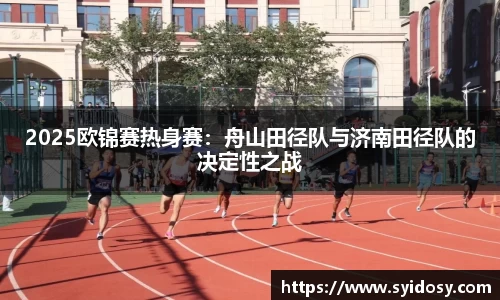2025欧锦赛热身赛:舟山田径队与济南田径队的决定性之战
2025欧锦赛热身赛:舟山田径队与济南田径队的决定性之战,成为了中国田径赛场上一场引人注目的对决。这场比赛不仅是两支队伍的实力较量,也是两座城市田径文化的碰撞。舟山田径队,凭借其强大的训练体系和深厚的竞技底蕴,向来以稳定的表现和强劲的爆发力著称。而济南田径队,则凭借其年轻一代选手的爆发力与快速成长,成为了近年来的黑马。这场热身赛不仅决定了双方的竞技水平,也对他们在即将到来的欧锦赛中能否脱颖而出,产生深远的影响。本篇文章将从以下四个方面进行详细分析:一是赛事背景与双方队伍介绍,二是两队在比赛中的战略布局,三是关键运动员的表现与影响,四是比赛后的总结与展望。通过这些方面的深入剖析,帮助读者更好地理解这场比赛的历史意义和未来可能的影响。
1、赛事背景与双方队伍介绍
舟山田径队的历史可追溯到多年前,虽然起步较晚,但凭借不懈的努力和对田径运动的热爱,已经逐步在全国范围内打响了名声。舟山队以其全员体能优异、技术稳定著称,特别是在短跑和接力项目中,成绩十分突出。近年来,舟山田径队更是在国内外大赛中取得了不少优异成绩,他们的崭新理念和训练模式,也成为了许多地方队伍效仿的对象。此次与济南队的比赛,无疑是他们为即将到来的国际大赛进行最后热身的关键时刻。
与舟山队相比,济南田径队起步较早,但他们的强势崛起主要是在近几年。济南田径队的运动员们充满激情与活力,尤其是他们的青年选手,在短跑和长跑项目中都展现出了较强的潜力。济南队的训练方式更偏重于创新,注重科技与传统训练手段的结合,这种独特的训练方法,使得他们的整体实力在近年来迅速提升。济南队的优势在于灵活的战术调整以及出色的团结合作能力,而这些优势在此次比赛中,成为了他们能否逆袭的重要因素。

这场热身赛的举行,不仅是两支队伍的较量,更是为即将到来的欧锦赛提前揭开了序幕。双方队伍在比赛中的表现,无论胜负,都将影响他们接下来的训练计划以及战术部署。舟山与济南,两个地方的田径文化,通过这场对决,将进一步推动中国田径的发展。
2、两队在比赛中的战略布局
在这场备受关注的热身赛中,舟山田径队展现出了极高的战术素养。作为一支经验丰富的队伍,舟山队在比赛前制定了详细的战略计划。他们深知比赛的关键是稳扎稳打,尽量减少失误。因此,舟山队在赛事中的整体战略布局,着眼于以稳重的步伐应对对手的挑战。特别是在接力项目中,舟山队选择了以稳为主,通过调整跑者顺序和合理分配体力,确保了全程的流畅性与配合度。
济南队的战略布局则相对灵活,他们强调高强度的进攻与短期内的体力集中爆发。济南队的教练组根据队员们的特点,合理安排了选手的上场顺序。与舟山队的稳健不同,济南队更注重发挥个别选手的特长,在短时间内迅速积累优势。例如,在短跑项目中,济南队选择了让年轻且爆发力强的运动员先行,力求一开始就拉开距离,以压制对方心理。
两支队伍的战略布局各具特色,舟山队的稳健打法与济南队的爆发力打法,形成了鲜明的对比。尽管两队的战术有所不同,但都展现出了高水平的战术执行力。最终,谁能在比赛中实现战术的最大效能,将直接决定胜负的归属。
3、关键运动员的表现与影响
比赛的胜负往往取决于几个关键运动员的表现。在这场舟山与济南的较量中,舟山队的短跑明星张伟毫无疑问成为了全场焦点。作为队伍的领军人物,张伟不仅在国内外大赛中屡创佳绩,在此次比赛中,他的表现依然稳定且出色。在100米和200米的比赛中,张伟凭借过硬的技术和强大的心理素质,成功帮助舟山队在多项赛事中占据了上风,确保了队伍的竞争力。
除了张伟,舟山队的接力组同样值得关注。在接力赛中,队员们的默契配合以及精确的交接棒动作,体现了他们长期艰苦训练的成果。尤其是接力比赛中,舟山队的最后一棒运动员李鹏发挥出色,凭借强劲的后程爆发力,将领先优势成功保持,最终帮助队伍稳稳夺得接力项目的胜利。
济南队的年轻选手们同样有着不俗的表现。特别是在200米短跑项目中,济南队的选手李琳展现了不输老将的爆发力。她在起跑阶段的快速反应,以及在中途阶段对体力的精准把控,使她成功实现了对对手的超越。济南队的其他运动员,如张涛和王宁,他们的配合与执行力,也为济南队赢得了接力项目中的一些关键胜利。
4、比赛后的总结与展望
这场热身赛的结束,对于舟山队和济南队来说,既是一个阶段性总结,也是一次新的起点。对于舟山队而言,尽管最终赢得了比赛的胜利,但他们依然意识到自身的一些问题,特别是在某些项目中的起跑与节奏掌控上,需要进一步强化。教练组表示,他们将在未来的训练中,专注于技术细节的打磨,力求在即将到来的国际赛事中,以更加稳定的状态迎接挑战。
而对于济南队来说,虽然比赛结果不尽如人意,但他们的表现也让人眼前一亮。特别是年轻选手们的成长和突破,给队伍带来了更多的信心。教练组表示,尽管这次比赛没有取得理想的成绩,但他们已经找到了许多问题所在,接下来将更加注重体能训练和心理调节,力争在未来的比赛中有所作为。
总结:
2025欧锦赛热身赛:舟山田径队与济南田径队的决定性之战,充分展现了中国田径运动的多样性和竞争力。两队各自的优势和不足在比赛中得到了淋漓尽致的体现,而这场比赛的结果,也将深刻影响他们未来的训练方向和比赛策略。无论是舟山队的稳健布局,还是济南队的爆发力打法,都展现了中国田径在不断变革和进步中追求卓越的精神。
未来,随着两队逐步加强训练和调整,预计他们将在2025欧锦赛中迎来更多的挑战和机遇。对于舟山和济南队来说,虽然这场热身赛已经结束,但他们的征途才刚刚开始。只有在不断磨砺中,才能最终在国际赛场上展示出最强的实力与最完美的状态。

发表评论